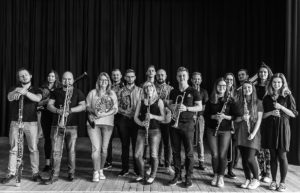Iuventus’ Chamber Concert
 31 May 2019, 7:00 p.m.
31 May 2019, 7:00 p.m.
Służewski Dom Kultury, ul. J. S. Bacha 15
With:
Justyna Adamczyk | flute
Sebastian Aleksandrowicz | oboe
Mikhail Bachyla | trumpet
Karolina Bober | clarinet
Edyta Chmielewska | French horn
Bartosz Duchnowski | French horn
Jacek Dziołak | clarinet
Karolina Gniazdowska | French horn
Karolina Mętrak | bassoon
Katarzyna Nej | oboe
Sebastian Portka | trumpet
Lech Polka-Przeworski | trombone
Maksymilian Rogacewicz | bassoon
Adam Stasiewicz | tuba
Adrian Szlęk | French horn
Marek Wroniszewski | piano
Programme:
Ludwig van Beethoven – Octet in E flat major Op. 103
Ferenc Farkas – Old Hungarian dances
Johannes Brahms – Five songs arranged for two French horns and piano (selection of 2 songs)
intermission
Victor Ewald – Quintet No. 1 for brass wind instruments (part 1)
Johann & Josef Strauss – Pizzicato-Polka, arr. Michael Kummer
Claude Debussy – Golliwogg’s cake walk, arr. Bert Mayer
Johann Sebastian Bach – Jesus bleibet meine Freude, arr. Thierry Caer
Just a Closer Walk with Thee (trad. arr. Don Gillis)
Gerardo Matos Rodrígues – La Cumparsita, arr. Sonny Kompanek
Kazimierz Machala – Sunset Rag
Music dedicated specifically to wind instruments enjoys an unusually long history – traces of such ensembles, for example, of many trumpeters, can be found in the earliest ancient iconography. The Middle Ages and Renaissance periods featured ensembles known as alta cappella, with a rich and diverse cast of pommers, krummhorns, dulcians, cornetts and others. Trombone ensembles and “choirs” of trumpets were also formed (these instruments were reserved in particular to emphasise the splendour of monarchs and aristocratic courts, hence trumpeters were long associated with separate, exclusive and hermetic traits). The loud sounds produced by wind instruments predestined them in particular for outdoor performances, but they were also appreciated in chamber music.
At the beginning of the 1880s, emperor Joseph II appointed his own court band – Kaiserliche und königliche Harmonie, initially a sextet that soon expanded to an octet including pairs of oboes, clarinets, bassoons and horns. This ensemble was considered to be the noblest and most “classical”. The largest number of compositions was also written for this grouping by Mozart and other composers of this era.
Beethoven’s charming and serene Octet in E flat major (one of his very early pieces despite the seemingly high opus number, the result of its later release) is actually a canonical example of so-called Harmoniemusik. The nineteenth century, on the other hand, witnessed the development of the custom of transcribing well-known compositions into various arrangements for wind instruments, selected as needed, a trend that would accelerate in the following century. One special variation was the brass quintet (most commonly consisting of two trumpets, a horn, a trombone and a tuba, although other variations are possible), often accompanied by orchestral soloists who were given the opportunity to show off their dazzling virtuosity.
The programme of the May concert refers to these traditions and provides something for everyone – in addition to original compositions for wind ensembles, such as the above-mentioned Octet by Beethoven and Ewald’s Quintet, listeners will enjoy bold transcriptions of repertoire from Baroque to contemporary popular music and jazz. The splendid soloists of the wind instruments of the Jerzy Semkow Polish Sinfonia Iuventus Orchestra cordially invite you to attend. [Piotr Maculewicz]
Free admission, tickets to download:
https://bit.ly/2VnVz6N
